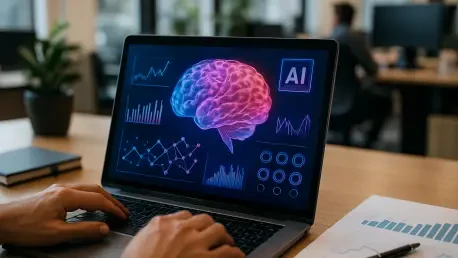What if the secret to revolutionizing hiring in 2025 lies in a perfect synergy of artificial intelligence (AI) and human intuition, rather than choosing one over the other? Picture a recruitment process where algorithms pinpoint top talent in seconds, yet a personal conversation still seals the deal. In an era where technology drives nearly every industry, staffing faces a unique challenge: how to harness AI’s efficiency without losing the empathy that builds lasting workplace relationships. This exploration uncovers a transformative approach, blending cutting-edge tools with the irreplaceable human touch to redefine how teams are built.
Why Staffing Needs a New Playbook in the AI Era
The staffing landscape today is under intense pressure to adapt to a tech-driven world. With over 60% of employers already using automation in recruitment, the race to hire faster and smarter has never been more critical. AI offers undeniable advantages, from slashing time-to-hire to analyzing vast pools of candidate data, but it also raises questions about losing the personal connection that often determines a successful match.
This shift isn’t just about keeping up with trends; it’s about survival in a competitive talent market. Organizations that fail to evolve risk falling behind, yet those who lean too heavily on technology may alienate candidates craving meaningful interaction. The stakes are high, and finding a balance between digital innovation and human engagement has become a defining issue for HR professionals and recruiters alike.
The Challenges of Hiring in a Digital Age
Navigating the intersection of technology and talent acquisition reveals a complex web of hurdles. Candidate dissatisfaction often stems from impersonal, automated processes that leave individuals feeling like mere data points. Cultural misalignment, too, emerges as a persistent issue when algorithms prioritize skills over values or team dynamics, leading to hires that don’t stick.
Ethical concerns add another layer of difficulty. Algorithmic bias, for instance, can unintentionally filter out qualified candidates based on factors like age or background, undermining fairness. For business leaders, the challenge lies in leveraging AI to streamline hiring while ensuring these tools don’t compromise equity or the candidate experience, making a hybrid approach not just ideal but essential.
How AI and Human Insight Collaborate in Hiring Stages
Breaking down the recruitment process into key phases—sourcing, screening, and onboarding—reveals how AI and human insight can complement each other. In sourcing, AI shines by automating job description creation and matching candidates to roles with precision, scanning databases in moments to surface hidden talent. However, a strategic recruitment marketing plan remains crucial to ensure these tools target the right pools effectively.
Screening demands a stronger human presence to balance automation’s limitations. While AI can handle initial assessments and interview scheduling, personal interactions are vital for evaluating soft skills and cultural fit. Oversight is also necessary to address potential biases in algorithms, ensuring fairness isn’t sacrificed for speed—a reminder that technology must support, not dictate, decisions.
Onboarding offers another chance for synergy, with automation excelling in managing paperwork and compliance via platforms like mobile apps that provide round-the-clock access. Yet, maintaining open communication channels with recruiters ensures new hires feel supported, blending efficiency with a personal touch. This tailored integration across stages maximizes both speed and connection, crafting a seamless hiring journey.
Real-World Perspectives on AI in Recruitment
Insights from the field paint a clear picture of how this dual approach resonates with both candidates and experts. Surveys show that 68% of job seekers believe technology can’t fully replace personal interaction, while 72% see human engagement as critical during hiring. These statistics highlight a widespread desire for balance, where innovation doesn’t overshadow relationships.
Expert voices echo this sentiment. A staffing leader has noted that AI serves as a powerful tool to execute strategy, but it must enhance—never substitute—human judgment. Practical examples, like mobile apps that streamline onboarding while preserving recruiter accessibility, demonstrate that this harmony isn’t just theoretical. It’s a proven model that meets the demands of a modern workforce seeking both efficiency and empathy.
Actionable Steps for a Balanced Staffing Model
Turning theory into practice requires concrete strategies to merge AI with human insight effectively. Start by defining precise goals for AI, targeting specific pain points such as slow sourcing or repetitive onboarding tasks, ensuring technology aligns with overarching business objectives rather than operating in isolation. This focused approach prevents wasted resources and maximizes impact.
Next, prioritize human oversight during screening by using AI for initial filtering but relying on recruiters for in-depth interviews to assess nuances like team compatibility. Additionally, adopt accessible tech solutions, such as mobile platforms, to simplify onboarding while keeping communication lines open for personal support. Training staff to view AI as a partner, not a replacement, fosters a culture that values both innovation and creativity, avoiding over-reliance on automation.
Finally, commit to ongoing evaluation of AI tools for fairness and effectiveness, adapting based on candidate feedback and industry shifts. Regular monitoring builds trust and transparency, ensuring the system evolves with the needs of the talent market. These steps create a sustainable framework that harnesses technology’s speed while preserving the depth of human connection, setting a new standard for staffing excellence.
Reflecting on a Transformative Journey
Looking back, the exploration of AI and human insight in staffing reveals a powerful truth: the most impactful hiring strategies are those that embrace both elements in harmony. Each stage of recruitment, from sourcing to onboarding, benefits from a thoughtful blend of automation’s precision and empathy’s warmth, proving that neither can stand alone.
As organizations reflect on past practices, the path forward becomes clear through actionable strategies that balance efficiency with connection. Moving ahead, the focus should shift toward continuous adaptation, ensuring AI tools remain fair and effective while prioritizing candidate experiences. The next step lies in scaling this hybrid model, refining it with every hire to build teams that thrive on both innovation and trust.









